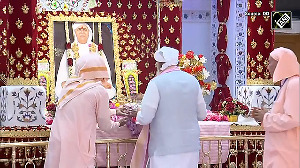Last year, former Oriental Bank of Commerce chairman and managing director B D Narang had to rush to the Reserve Bank of India headquarters on Mint Road at a very short notice to discuss the nitty-gritty of the takeover of Global Trust Bank.
After the RBI froze GTB's activities on a Saturday, Narang appeared as a white knight on Monday. By comparison, then Punjab National Bank chief S S Kohli had enough time to look into the books of Nedungadi Bank before taking it over.
Since 1969 when Bank of Behar was merged with State Bank of India, till last year's merger of GTB with OBC, the Indian central bank has been playing the role of a match-maker for the financial system.
Over the last three decades, over two dozen mergers have taken place in the banking sector. Notable among them are United Industrial Bank with Allahabad Bank (1989-90), New Bank of India with PNB (1989-90), Bank of Karad with Bank of India (1993-94), Bareilly Corp Bank with Bank of Baroda (1998-99), Sikkim Bank Ltd with Union Bank of India (1999-2000) and Benaras State Bank with Bank of Baroda (2002-03).
In all these cases, the RBI -- which has traditionally been the government's merchant banker, overseeing its annual borrowing programme -- has played the role of a M&A specialist.
The provocation has been to protect depositors' money. Indeed, in the Nedungadi bank case, where its accumulated losses had wiped out its entire net worth and the NPAs rose to 32 per cent of advances, the RBI first approached the State Bank of India (SBI) which was not too keen since (along with its associate, the State Bank of Travancore) it already had over 900 branches in Kerala which is where Nedungadi had most branches.
The RBI then approached two other big PSU banks but they too were not interested. (Traditionally, it has been the SBI which has taken over the most banks).
Though the ink on the GTB-OBC deal is barely dry, the market is already sniffing a lot more mergers. Indeed, over the past few months, the chiefs of some of the old private sector banks are being seen on Mint Road quite frequently, as the regulator puts pressure on them to chart out a course to strengthen their bones and add flesh to their balance sheets.
While foreign banks will have to wait for four years to pick up the banks they want, the RBI is willing to consider a takeover even today if it feels the domestic bank cannot be revived.
The preamble to the forthcoming round of M&As, of course, is the RBI's recent framework for mergers between two banks, and a bank and a non-banking finance company (NBFC). Indeed, RBI-speak on 'the systemic benefits' of such mergers really means consolidate or perish.
The RBI wants all banks to have a capital base of Rs 300 crore (Rs 3 billion) over the next three years. Most of the old private sector banks are far from anywhere near this (see table).
|
Ready for consolidation | |||||
|
Rs crore, for 2003-04 |
Capital |
Net Worth |
Net Profit |
CAR |
NPA(%) |
|
Bank of Punjab |
105 |
243.7 |
37 |
12.6 |
4.7 |
|
Bank of Rajasthan |
107.8* |
350.7* |
35.0* |
12.8* |
2.5* |
|
Bharat Overseas Bank |
15.8* |
198.4* |
20.1* |
15.0* |
1.6* |
|
Catholic Syrian Bank |
10.6 |
194 |
56.5 |
11.2 |
4.7 |
|
Centurion Bank |
101.3* |
193 |
25.1* |
21.4* |
2.5* |
|
City Union Bank |
24 |
202.9 |
57 |
13.4 |
6.4 |
|
Development Credit Bank |
39.4 |
286.4 |
17.4 |
14.1 |
4.9 |
|
Dhanlakshmi Bank |
32.1 |
134.1 |
17.5 |
13.6 |
6.7 |
|
Federal Bank |
21.8 |
648.8 |
136.3 |
11.5 |
2.9 |
|
ING Vysya Bank |
22.7* |
747.3 |
-38.2* |
9.1* |
2.1* |
|
J&K Bank |
48.5* |
1593.7 |
115.1* |
15.2* |
1.5 |
|
Karnataka Bank |
40.4 |
698.2 |
133.2 |
13 |
5 |
|
Karur Vysya Bank |
18.0* |
712 |
105.3* |
16.1* |
1.7* |
|
Lakshmi Vilas Bank |
11.5 |
226.6 |
41.1 |
13.8 |
5.4 |
|
Lord Krishna Bank |
56.7 |
139.2 |
26.4 |
16.7 |
6.1 |
|
Sangli Bank |
22.3 |
86.2 |
12.1 |
13.7 |
6.6 |
|
South Indian Bank |
47.7* |
394.9 |
8.7* |
9.9* |
4.6 |
|
Tamilnad Mercantile Bank |
0.3 |
476.8 |
80.7 |
21.07 |
5 |
|
United Western Bank |
29.9 |
304 |
31 |
10.13 |
9 |
|
NPA=Non performing assets CAR= Capital adequacy ratio | |||||
|
* Data for 2004-05 | |||||
In fact, over 90 per cent of these banks have a capital base of less than Rs 100 crore (Rs 1 billion). Some of them even do not have a net worth of Rs 300
Most of them are profit-making and have an adequate capital adequacy ratio. At least seven of them have over 5 per cent net NPA in 2004 which might have come down last year.
The main problem is their low capital base. Banking is fast becoming a big boys' game where niche, community players may not find a place any more.
Broadly, the old private sector banks can be categorised into a few groups. Banks like Karur Vysya Bank, Federal Bank and City Union Bank have good assets, a fair-sized branch network, reasonably modern technology platforms and reasonably efficient management.
Karnataka Bank, South Indian Bank, Laxmi Vilas Bank, Bank of Rajasthan and Tamilnad Mercantile Bank too have well spread branch networks. However, they lag behind on the technology front.
Banks like Lord Krishna Bank, Catholic Syrian Bank, Dhanalakshmi Bank, United Western Bank, Sangli Bank and Ganesh Bank of Kurundwad lack both in term of quality of assets as well as governance.
Three of them -- Catholic Syrian Bank, Sangli Bank and Ganesh Bank of Kurundwad -- are not listed on the bourses either.
All these banks are small and suffer from high cost of operations because they lend to small businesses, incurring high transaction costs.
Their promoters are not too keen on growing the business either as they do not want to lose control over the banks. In cases where they are willing to sell stakes, they look for a price which is not market-related. Some of them have even gone to the extent of making false promises to drum up their stock prices.
Most of these banks are low on technology, high on staff strength and to make the matters worse, their employees are unionised. Besides, some of the old private banks are controlled by certain communities.
The Nadar community holds about an 80 per cent stake in Tamilnad Mercantile Bank; the coastal-based Brahmins of Mangalore control Karnataka Bank; the Vysyas from Tamil Nadu have considerable say in Karur Vysya Bank and Laxmi Vilas Bank; and the Syrian Catholic community dominates Catholic Syrian Bank.
It doesn't help that the promoters' holding in most of these banks is minuscule. For instance, the promoters' stake in Karur Vysya Bank is 4.43 per cent, in Laxmi Vilas Bank it is 1.77 per cent and it is almost non-existent in Karnataka Bank. While an open offer is an easy way to take over the bank, this cannot be done without the full backing of the regulator.
How comfortable the RBI is in its new pair of shoes is anybody's guess, but to governor YV Reddy's credit, he has set the ball rolling. The promoters of the smaller banks now have no choice but to join the discussion table.
Once the RBI gets a clear picture of the health of some of the smaller players it may even prescribe an open bidding system. As long as the depositors are protected and employees' jobs assured, the RBI should not have any problem with promoters' making a little money.
Of course, if the RBI doesn't hasten the process, whatever valuations the older banks may command will go down. For in another four years, as foreign banks start scaling up, they may not even be interested in many of the acquisitions that come their way.







 © 2025
© 2025